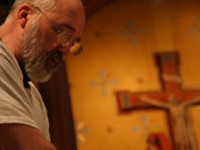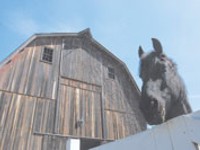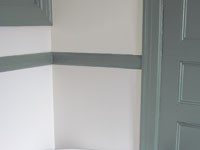Much of our region's character can be found in its architecture: The homes, industrial buildings, schools, office buildings, and churches that were built when Rochester's star was rising. Now many of these buildings are abandoned or are facing vacancy or bankruptcy, while new developments and building projects crop up all around. If these older structures are not preserved, we could lose them; and along with them, we will lose a part of history.
Some talented and devoted architects, craftspeople, designers, and builders worked on these buildings. They were built to last, with quality and beauty as the first priorities. But one and two hundred years later, they need some help.
This is an updated list of some of our area's most stressed places. But these are only the highlights. As Peter Siegrist, Director of Preservation Services at the Landmark Society, says, "the list is endless."
Endangered
Academy Building, 13 South Fitzhugh Street, Rochester
So called because when it was built in 1872 it was the Rochester Free Academy, the Gothic Revival Academy Building is now office space. But as tenants trickle out to the suburbs, the building's future is uncertain. Designed by Andrew Jackson Warner.
Albion's main street
While many of the area's Erie Canal towns have historic value, Albion is particularly special because most of its canal-era buildings are still intact. The town center is in good physical shape and has a consistent streetscape, but most of the buildings are empty. And now, zoning for a Wal-Mart Supercenter just outside the village has been approved.
Armory, East Main Street
Together with the Eastman Dental Dispensary and the Auditorium Center, the Armory cuts an impressive figure along East Main Street. It's now vacant, and though it is a very large space, there are no plans for its use.
Eastman Dental Dispensary, East Main Street
The Italian Renaissance-style brick building, built in 1917 by George Eastman as a children's dental clinic, inspired copies in Brussels, Paris, Rome, and Stockholm. It's been empty since 1977.
King Street houses, Susan B. Anthony neighborhood
Many of the older homes in this preservation district, in particular a string along King Street, are empty, and despite some strong efforts by the Landmark Society, are very slow to sell. The neighborhood, with its ideal downtown location, small public square, and good housing stock, has the potential to be a thriving urban village. The Susan B. Anthony House is here.
Parazin Building, 208 Mill Street
The Parazin Building is one of the oldest buildings in the High Falls district (it was built in 1826). After passing through several owners' hands, it now sits empty.
Sibley Building, 228 East Main Street
The Sibley Buildings is at the center of the debate over downtown revitalization efforts. Built in 1905, it was once a major regional department store and a downtown activity hub. Now, thanks to the owner's debt, vacancy problems, and planned downtown development projects, its future is uncertain. The major tenant, Monroe Community College, will most likely move when Renaissance Square is completed (an architect was just chosen).
Valentown Hall, Valentown Road, Victor
Valentown, built as a shopping plaza in 1879, is now home to historian J. Sheldon Fisher's eclectic collection and is a museum operated by the Victor Historical Society. The museum has a plea out to the community, asking for volunteer time and supplies for the effort to rebuild the giant wood structure.
Updates
Baltimore and Ohio Railroad Station, 320 West Main Street
Home to the one and only Garbage Plate, Nick Tahou Hots' downtown location is also notable for its building: a former passenger terminal for the Baltimore and Ohio Railroad. The Tahou family, which owns the building, has expressed the hope that a nonprofit group would take over the building and secure grants for the necessary repairs, which include a new roof.
Bevier Memorial Building, 42 South Washington Street
Designed by prominent Rochester architect Claude Bragdon in the early 1900s for the Mechanics Institute (later the Rochester Institute of Technology), the Bevier building is now empty, but was recently bought by a new owner. The Rochester City School District has been talking about the possibility of moving its offices back into the building.
School #37
After extensive debate over school closings, it was decided that the elementary school on Congress Avenue in the Southwest section of the city will close in June. The question: How will the 88-year-old, recently renovated building be used?
Seneca Park, St. Paul Street
The 297-acre park, designed by Frederick Law Olmsted in the late 1800s, is home to the county's Seneca Park Zoo. The zoo recently announced the plan for an expansion, a hot-button issue for preservationists who have opposed the zoo's encroachment on one of the area's most important parks. Support was won because the zoo dropped its idea for adding on a parking lot. A task force has been set up, including Landmark Society representatives, to make sure the new elephant exhibit doesn't take away from the park.
Sonnenberg Gardens, 151 Charlotte Street, Canandaigua
There's good news for the 40-room Queen Anne mansion and extensive grounds that makes up the Sonnenberg Mansion and Gardens: The museum's financial trouble was alleviated earlier this year when the NYS parks office decided to acquire it as a state historic park. As part of that transfer, NYS challenged Sonnenberg to raise $250,000 from the community. The capital campaign closed January 26 with a total of $281,851.
Wehle Building, Webster Ave
With grants, the North East Area Development neighborhood association successfully renovated this triangular building on Webster Avenue and the nearby Dazzle Theater --- important and resource-intensive investments in a neighborhood that needed them. But the daycare center on the first floor of the Wehle Building closed, and the building is now empty.
The Landmark Society will hold its 19th Annual Regional Preservation Conference, "Maintaining Hometown Character in the 21st Century," on Saturday, April 30, at Trinity Episcopal Church, Fall Street, Seneca Falls, 8 a.m. to 3:45 p.m. $40. www.landmarksociety.org, 546-7029 ext 10







